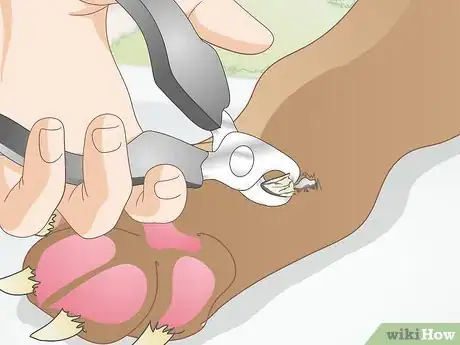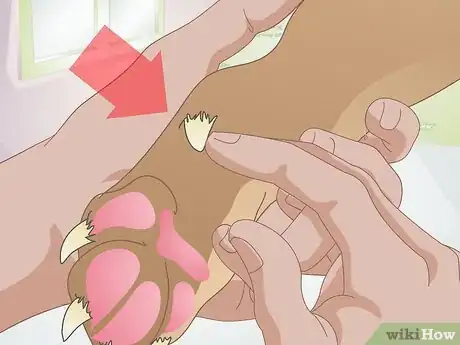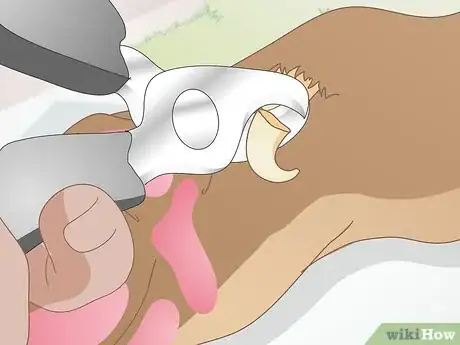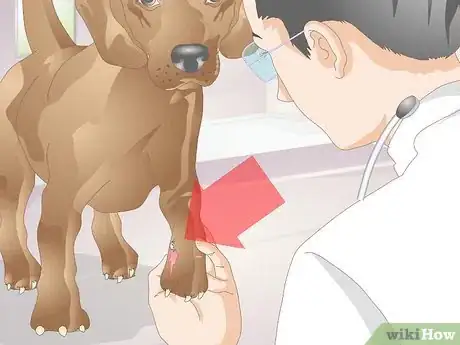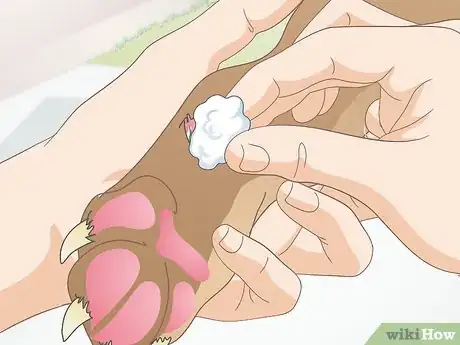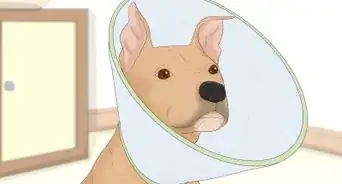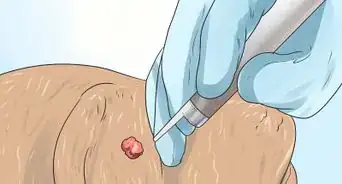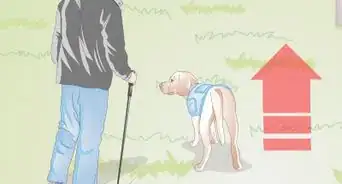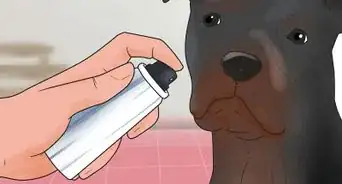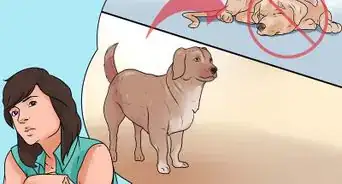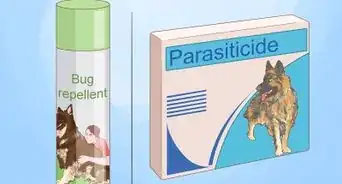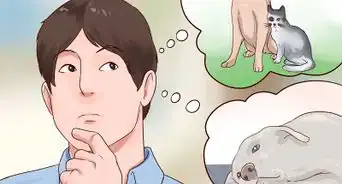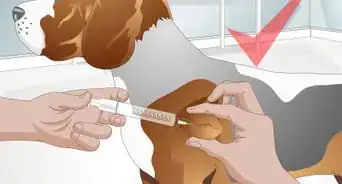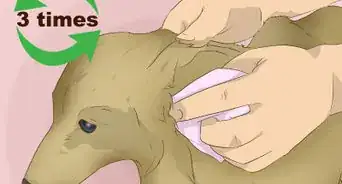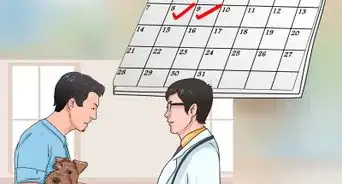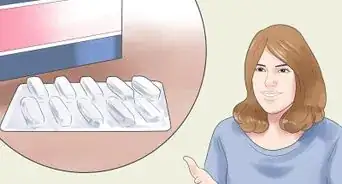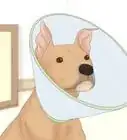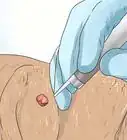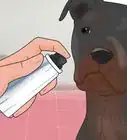This article was co-authored by Marie Lin. Marie Lin is a Licensed Pet Groomer and the Owner of Marie's Pet Grooming, a grooming salon based in New York City. Marie has over 10 years of pet grooming experience specializing in dogs and cats. She earned her pet grooming certification from the American Academy of Pet Grooming New York in 2009 and is also a member of the National Dog Groomers Association of America. She earned a Master of Business Administration (MBA) from Hawaii Pacific University in 2007.
There are 9 references cited in this article, which can be found at the bottom of the page.
This article has been viewed 118,558 times.
Many dogs have dew claws, the claws just above the paws on the lower part of their leg. Dew claws are part of most dog's normal biology, and just like the rest of your dog's nails, they require some care to ensure that they are healthy and don't cause your dog any pain or trouble. Regular checks and trimmings, as well as immediate attention to any dewclaw injury or infection, will keep your dog's dewclaw healthy for the long run.
Steps
Locating and Maintaining the Dew Claw
-
1Find the dew claw. The dew claw is the claw that most dogs have on the inner portion of their lower leg, little ways above the rest of the paw. Almost all dogs naturally have dew claws on their front legs, and some have them on the back, as well.[1]
- Some dog owners opt to have their dog's dew claws removed when they are still puppies to avoid potential injury or tearing. If you have a rescue dog or a dog from a renowned breeder, it is possible that they may not have dew claws per the choice of their previous owners.
-
2Check for a healthy dew claw. The dew claw is prone to cracks, breaking, and tearing, so it is important to check regularly to ensure that the claw is healthy and not causing your dog any pain. Look carefully at the claw once every week or so to see if there is any chipping, peeling, extended cracks, or other symptoms of an injured dew claw.[2]
- A healthy dew claw should be smooth and a relatively consistent color. Some color variation along the claw is normal, but discoloration such as red or brown within the claw may indicate bleeding or another injury.
Advertisement -
3Decide whether to declaw. While there are no strict veterinary guidelines regarding if you can have your dog's dew claws removed, the general school of thought on the subject is leaving it there unless otherwise necessary. Declawing generally happens when the dog is still small and must be done by a trained veterinarian.
- Declawing may be beneficial for dogs that work, hunt, or otherwise, spend a lot of time being active outdoors or in variable environments. Farm dogs, hunting dogs, service dogs, and police dogs are often declawed to help prevent the claw from catching or sustaining injury.
- If your dog is not going to be performing intense physical activity and will live more like a household pet, it is generally considered easier to keep the claw and maintain it properly.
Trimming The Dew Claw
-
1Examine your dog's dew claw. Trimming your dog's dew claw is important for their continued health and well-being. Trimming too close or with the wrong tools could actually cause injury to your dog, though. Decide whether you are capable and comfortable trimming your dog's claw.[3]
- If your dog has dark, opaque claws, trimming them is likely best left to a professional. The claws have a fleshy bed called the quick that extends partway down the claw. Cutting into the quick is painful and could seriously injure your dog. If you cannot see the quick, it is best not to cut their nails yourself.
- Make sure that you have a nail trimmer meant specifically for dog's nails. The types of nail trimmers humans use can cause cracking and splitting on dog nails. Head to your local pet shop to get trimmers that will keep the claw healthy.
-
2Visit your groomer. If you do not feel comfortable trimming your dog's dew claw on your own, take your dog to your local groomer. Many groomers offer walk-in and a la carte nail trimming or grindings. Generally, your groomer will be faster, safer, and less traumatic for your dog than trying to trim the nails yourself.
- Ask your groomer about nail grinding options, as well as nail trimming. A grinding uses a rotary nail file to slowly grind the claw down to an appropriate length. This not only trims the nail, but rounds it out to prevent catching, cracking, and splitting.[4]
-
3Find the right length. If you decide to trim your dog's nails, you need to determine the right length of the nail. The nail is too long and needs trimming if it starts to curl and wrap around upward and back toward the dog's leg. Trim the nail to a length that cuts away the curl, but leaves visible room between the quick and the cut.[5]
- It is imperative to not cut the dog's claw too short. Always opt for longer if you are unsure. You can go back and trim more if necessary, but cutting too close could cause serious pain and injury to your dog.
EXPERT TIPMarie Lin is a Licensed Pet Groomer and the Owner of Marie's Pet Grooming, a grooming salon based in New York City. Marie has over 10 years of pet grooming experience specializing in dogs and cats. She earned her pet grooming certification from the American Academy of Pet Grooming New York in 2009 and is also a member of the National Dog Groomers Association of America. She earned a Master of Business Administration (MBA) from Hawaii Pacific University in 2007.Licensed Pet Groomer
 Marie Lin
Marie Lin
Licensed Pet GroomerExpert Warning: Clip your dog's dew claws right below the vein, and don't wait until they grow extremely long to trim them. A dog's dew claws do not get filed down when the dog walks the way its other nails do. If they're allowed to grow, they can actually curve back and cut into the skin, which is extremely painful for the dog.
-
4Trim the nail. Once you have found the right length, trim the nail using nail clippers made specifically for trimming dog claws. Unlike nail trimmers meant for human use, these put pressure on the sides of the nail, instead of the top and bottom, which helps prevent painful and potentially dangerous cracking and splitting.[6]
- Using dog nail trimmers is advisable for at-home groomers instead of using a grinder. Those unexperienced with grinders may cause accidental injury to the nail or nail bed.
Tending To An Injured Dew Claw
-
1Go to the vet. If your dog has a nail injury that has cut them down to the quick, get your dog to your vet or the nearest animal hospital immediately. This is a painful injury for your dog, and requires professional treatment and often sedation.[7]
- If your dog will let you, treat the bleeding using gauze or a band-aid. Then, rush your dog to the vet for further evaluation and treatment.
-
2Treat a break or crack. If your dog sustains a dew claw injury that has not cut them to the quick, treat the break or crack in the nail quickly to prevent further damage. In these cases, it is still a good idea to call your vet for advice and further information.[8]
- Remove the broken pieces. If your dog breaks or chips part of their nail, remove the broken pieces using your claw trimmers to prevent further injury.
- Stop any bleeding by covering the injury using clean gauze and applying pressure to the area for a few minutes.
- Clean the wound by bathing the paw in warm water to remove any immediate dirt or debris. Then, use an antiseptic spray or wipe only on the toe that was impacted to prevent potential infection.
- Bandage the wound with a gauze wrap or a bandage meant to work on a pet's foot, available from your vet or at local pet stores. Change the bandage daily to keep the wound clean until it heals.
- Consult your vet to ensure that your dog does not need to be brought in and to get further recommendations for treatment.
-
3Treat an infection. Your dog's dew claw may become infected due to trauma or injury around the claw, or due to fungal infections. Treat an infection of the dew claw quickly with evaluation and care from your vet.[9]
- Symptoms of a dew claw infection include soreness and inflammation around the dew claw, nail overgrowth, unexpected peeling and chipping of the nail, and discoloration.
- If you believe your dog may have an infected dew claw, contact your vet immediately to schedule an appointment. Your vet will best be able to advise you on proper physical and medicinal treatments.
- Treatment may include antibiotic or antifungal medication, as well as medicated foot baths or soaks. In extreme circumstances, removal of the nail plate may be necessary.
Community Q&A
-
QuestionI found dew nails on both back paws that are embedded and infected. How can I avoid this from happening again with my groomer?
 Community AnswerGo to another groomer and leave a review online so other people are aware of the issue.
Community AnswerGo to another groomer and leave a review online so other people are aware of the issue.
Warnings
- Trimming too close to the quick can cause very serious injuries for your dog. If you are unable to properly identify the quick, go to your groomer for a nail trimming.⧼thumbs_response⧽
References
- ↑ https://www.psychologytoday.com/blog/canine-corner/201410/why-do-dogs-have-dewclaws
- ↑ http://www.pets4homes.co.uk/pet-advice/ways-in-which-the-dewclaws-can-serve-an-important-purpose-for-the-dog.html
- ↑ http://www.aspca.org/pet-care/dog-care/dog-grooming-tips
- ↑ http://www.vetstreet.com/dr-marty-becker/are-nail-grinders-safe-to-use-on-dogs
- ↑ https://www.vetmed.wsu.edu/outreach/Pet-Health-Topics/categories/procedures/dogs/clipping-your-dog's-claws
- ↑ http://www.petgroomer.com/grooming101/articles/nail_clipping-revised.htm
- ↑ http://smartdogowners.com/dew-claw-injuries/
- ↑ http://www.petful.com/pet-health/how-to-treat-a-torn-dog-nail/
- ↑ https://www.cuteness.com/article/dog-claw-infections
About This Article
To care for your dog’s dew claw, which is the claw on the lower part of its leg, check it every week or so for cracks, breaks, or tearing. If you find an injury down to the claw, you should take your dog to the vet. However, if the injury has not reached the quick, you should clean and bandage it at home. If you find that your dog's dew claw is starting to curl towards its leg, you should trim it, since this can cause pain and discomfort, but be careful not to cut it too short, which could injure your dog. For example, if your dog’s claws are dark and opaque, you should probably leave trimming them to a professional, since you could risk cutting into the quick. If you’re not confident about doing it yourself, you should go to a groomer. For more tips from our Veterinary co-author, including how to treat a damaged or infected dew claw, read on!


